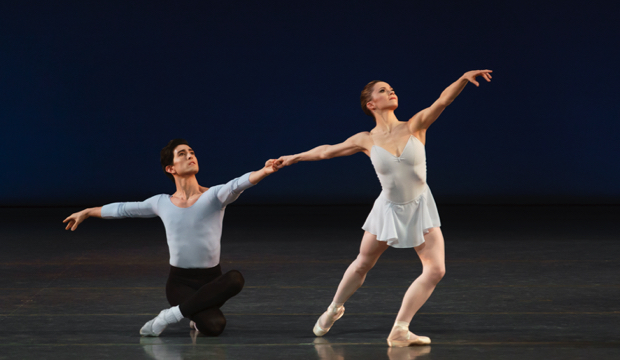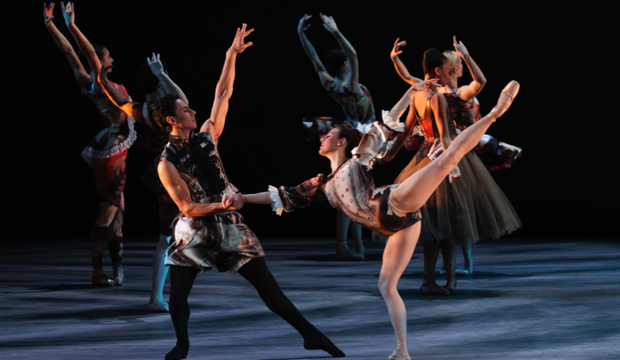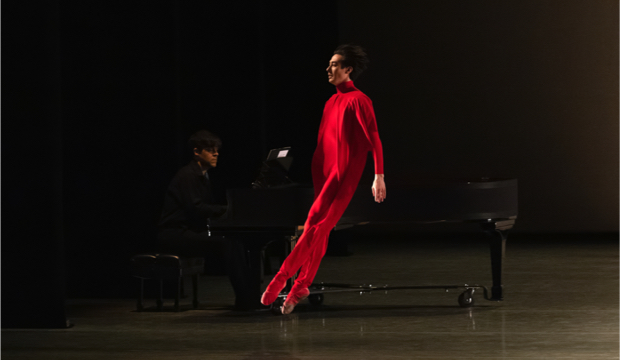New York City Ballet Mixed Bill Review ★★★★★
One of the most exciting neo-classical ballet companies in the world, New York City Ballet, brought a mixed bill of works old and new to Sadler's Wells
NYCB in Justin Peck's Rotunda. Photo: Erin Baiano
Two pieces stood out in the mixed programme New York City Ballet brought to London in its first visit after a 16 year absence (and how we’ve missed it!): Balanchine’s Duo Concertant, set to music by Stravinsky, and Kyle Abraham’s Love Letter (on shuffle) set to a series of songs by James Blake.
New York City Ballet (NYCB) was founded by the Russian emigré George Balanchine and run in his image until his death in 1983. A prolific choreographer, NYCB’s style and repertoire retain the indelible mark of the master, and watching his 1972 Duo Concertant it’s easy to see why: like so many of Balanchine’s works, it remains as fresh and engaging as if newly-minted.
A couple in simple costumes that privilege the line – Indiana Woodward, enchanting, and Taylor Stanley in the performance I attended – stand by an on-stage piano listening raptly to pianist Elaine Chelton and violinist Kurt Nikkanen. The dancers seem to be absorbing the music, getting ready to re-enact it in movement, which they eventually do.

NYCB, Megan Fairchild and Anthony Huxley in George Balanchine's Duo Concertant. Photo: Paul Kolnick
The choreography is neo-classical – clean, crisp and minutely attentive to all the nuance of the score, it is also light and witty
Kyle Abraham’s Love Letter (on shuffle) is its polar opposite, but just as thrilling – in fact, the moment it ended I longed to see it all over again. A 2022 piece for 16 dancers, it’s the fourth work for NYCB by the African American choreographer, whose style seamlessly blends impeccable classicism and a modern day street vibe.
With outlandish costumes by fashion designer Giles Deacon, and dazzling, painterly lighting by Dan Scully, Love Letter (on shuffle) is set to a series of yearning songs by James Blake, and although it has a very tenuous narrative – a man looks for love, and eventually finds it – it's primarily a sequence of dances for a variety of groupings, which the dancers appear to enjoy tremendously despite its difficulty, with gargouillades, fast beats and turns aplenty.

NYCB, Roman Mejia and Tiler Peck in Kyle Abraham's Love Letter (on shuffle). Photo: Erin Baiano
The programme opened with resident choreographer Justin Peck’s Rotunda (pictured top), an interesting work which attests to NYCB’s ongoing evolution. A piece for a dozen dancers in practice costumes, who could be just shooting the breeze after class, it is clearly influenced bye Balanchine in its intricate groupings and clean lines, but it has its own contemporary style. Not earth-shattering, it is nevertheless a good, solid, entertaining opener.
Pam Tanowitz is always interesting, always innovative, and her Gustave le Gray No. 1, the fourth piece in the programme, had much to enjoy, though it was perhaps not up to her most compelling. It’s a work for four dancers (sex immaterial) dressed in Reid Bartelme and Harriet Jung’s stunning, bright red costumes, with lengths of flowing fabric running from shoulder to ankle, which flared with movement to create a flying foxes effect.

NYCB, Gustav le Gray No. 1, Photo: Erin Baiano
The steps in soft shoes are, as in all other Tanowitz works, ultra-precise, set against Caroline Shaw’s plinky piano piece, which gives the work its title and was played on stage by Stephen Gosling.
A final word of praise to the dancers, exponents all of the thrilling American style of ballet, with its speed, attack and pizzazz. Come back soon!
New York City Ballet (NYCB) was founded by the Russian emigré George Balanchine and run in his image until his death in 1983. A prolific choreographer, NYCB’s style and repertoire retain the indelible mark of the master, and watching his 1972 Duo Concertant it’s easy to see why: like so many of Balanchine’s works, it remains as fresh and engaging as if newly-minted.
A couple in simple costumes that privilege the line – Indiana Woodward, enchanting, and Taylor Stanley in the performance I attended – stand by an on-stage piano listening raptly to pianist Elaine Chelton and violinist Kurt Nikkanen. The dancers seem to be absorbing the music, getting ready to re-enact it in movement, which they eventually do.

NYCB, Megan Fairchild and Anthony Huxley in George Balanchine's Duo Concertant. Photo: Paul Kolnick
The choreography is neo-classical – clean, crisp and minutely attentive to all the nuance of the score, it is also light and witty
Kyle Abraham’s Love Letter (on shuffle) is its polar opposite, but just as thrilling – in fact, the moment it ended I longed to see it all over again. A 2022 piece for 16 dancers, it’s the fourth work for NYCB by the African American choreographer, whose style seamlessly blends impeccable classicism and a modern day street vibe.
With outlandish costumes by fashion designer Giles Deacon, and dazzling, painterly lighting by Dan Scully, Love Letter (on shuffle) is set to a series of yearning songs by James Blake, and although it has a very tenuous narrative – a man looks for love, and eventually finds it – it's primarily a sequence of dances for a variety of groupings, which the dancers appear to enjoy tremendously despite its difficulty, with gargouillades, fast beats and turns aplenty.

NYCB, Roman Mejia and Tiler Peck in Kyle Abraham's Love Letter (on shuffle). Photo: Erin Baiano
The programme opened with resident choreographer Justin Peck’s Rotunda (pictured top), an interesting work which attests to NYCB’s ongoing evolution. A piece for a dozen dancers in practice costumes, who could be just shooting the breeze after class, it is clearly influenced bye Balanchine in its intricate groupings and clean lines, but it has its own contemporary style. Not earth-shattering, it is nevertheless a good, solid, entertaining opener.
Pam Tanowitz is always interesting, always innovative, and her Gustave le Gray No. 1, the fourth piece in the programme, had much to enjoy, though it was perhaps not up to her most compelling. It’s a work for four dancers (sex immaterial) dressed in Reid Bartelme and Harriet Jung’s stunning, bright red costumes, with lengths of flowing fabric running from shoulder to ankle, which flared with movement to create a flying foxes effect.

NYCB, Gustav le Gray No. 1, Photo: Erin Baiano
The steps in soft shoes are, as in all other Tanowitz works, ultra-precise, set against Caroline Shaw’s plinky piano piece, which gives the work its title and was played on stage by Stephen Gosling.
A final word of praise to the dancers, exponents all of the thrilling American style of ballet, with its speed, attack and pizzazz. Come back soon!
TRY CULTURE WHISPER
Receive free tickets & insider tips to unlock the best of London — direct to your inbox
| What | New York City Ballet Mixed Bill Review |
| Where | Sadler's Wells, Rosebery Avenue, London, EC1R 4TN | MAP |
| Nearest tube | Angel (underground) |
| When |
07 Mar 24 – 10 Mar 24, 19:30 Thu & Sat mats at 14:30. Sun at 14:00 only. Dur.: 2 hours 15 mins inc to intervals |
| Price | £7.50-£85 (+booking fee) |
| Website | Click here to book |